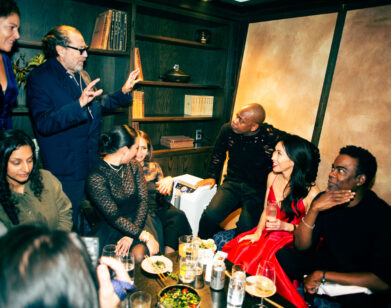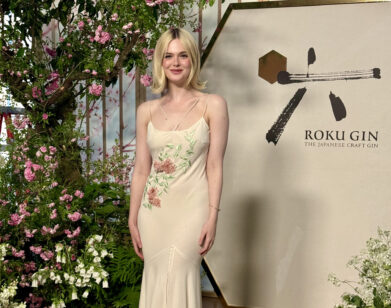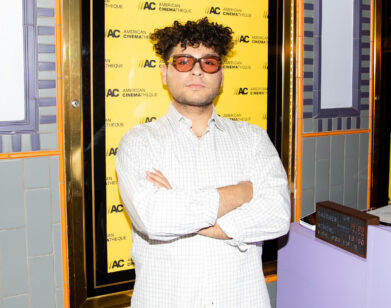fashion
Designer Lucila Safdie Makes Clothes for the Tumblr Girls
For fashion designer Lucila Safdie, girlhood is insatiable. Safdie’s girl, like many, is a media vampire, latching on to an obsession and draining it before moving to the next. She’s watched every Sofia Coppola film, posts Sylvia Plath quotes on her Tumblr, and hyperfixates on the tragic blondes of Hollywood. This sad girl is a coming-of-age archetype, but it’s authentic. She’s just a girl—she posts irreverent selfies in dainty polka dot sets, flirty lace dresses, and shorts exploding with frills. It’s all steeped in the vibe of the blogging era, when the 27-year-old Argentine, London-based designer discovered her own fashion fixations. But don’t call it indie sleaze. (“It feels super shallow to me,” she says.) Each of Safdie’s collections is a vignette, inspired by those patron saints of melancholic feminine storytelling. And everyone from Rachel Sennott to Sexyy Red has posed online in the brand, styling themselves as a girl on the brink of… something. In her newest collection, “Farewell Princess,” Safdie dives into her obsession with the the lives and deaths of starlets like Grace Kelly, marrying tweed and puff sleeves with her typical ruffles and booty shorts. Below, she tells us all about Tumblr-era magazines, cult film club, and her vision of girlhood.
———
MEKALA RAJAGOPAL: Hey. Are you in London?
LUCILA SAFDIE: Yeah, I’m at my house. I was so happy when you emailed me. I love reading Interview Magazine interviews. They feel smart or whatever.
RAJAGOPAL: The more casual you are, the more smart it comes across sometimes.
SAFDIE: I feel that in general, if you don’t take yourself too seriously.
RAJAGOPAL: Right. How long have you lived in London?
SAFDIE: I think it’s seven or eight years, which is insane. I moved when I was 18 for university and just stayed here.
RAJAGOPAL: What was your first artistic interest when you were younger?
SAFDIE: I’d say it was fashion, to be honest with you. So stupid but—
RAJAGOPAL: No, I feel the same.
SAFDIE: Yeah. We’re probably a similar age, and I feel like when we were young, it was really the moment of fashion blogging. So if you were on the internet in any part of the world, you were into that. But then I went to a film high school, so I got really, really into film. For a while, I thought maybe that’s what I would pursue, but then I went back to the source and studied fashion.
RAJAGOPAL: So you developed an interest in fashion from being online.
SAFDIE: Yeah, definitely. I feel like growing up in Argentina, everything was a bit delayed because it’s so far, and sometimes they need to translate stuff. But nowadays, the internet is much bigger than what it used to be.
RAJAGOPAL: It’s like everyone exists on the same internet now. The lines are more blurred.
SAFDIE: Yeah. All the kids there know how to speak English. My little brother speaks perfect English, but when I was younger, it was a bit harder. And then if I traveled, I would buy fashion magazines as well.
RAJAGOPAL: What magazines did you read?
SAFDIE: Teen Vogue or Seventeen.
RAJAGOPAL: The classics.
SAFDIE: I also was super into Love magazine, and also Rookie magazine, that was really cool.
RAJAGOPAL: Oh, Rookie Mag was a symbol of an era.
SAFDIE: And Tavi [Gevinson] was so young, the same age as me or slightly older. So seeing her wearing Miu Miu at fashion shows, I was like, “Oh my god.”
RAJAGOPAL: Super aspirational. What websites were you on?
SAFDIE: I mainly used a Blogspot that I actually found recently and I was dying at the things I was posting, thinking I was taking really amazing photos. And then Tumblr a bit later on, but I feel like people still have Tumblr. I still use Tumblr a lot.
RAJAGOPAL: I want to get back into it. I was super obsessed with it when I was younger, but I haven’t been on there in a while.
SAFDIE: I like it because none of my friends in real life have it, and I don’t have my name or anything on my Tumblr, so I just literally write stuff like, “Oh my god, he texted me and I’m feeling so…”
RAJAGOPAL: Like a diary? So you’re using it like people use Twitter.
SAFDIE: [Laughs] Yeah. Hopefully, no one knows, but it feels good. I’m on a Grace Kelly Facebook group, where all these ladies post pictures of Grace Kelly, and another group of Elizabeth Taylor. So I just screenshotted that and put a random lyric on it, like a collage.
RAJAGOPAL: I remember when everyone used to post those. Were there any aesthetics of the blog era that you were obsessed with?
SAFDIE: It’s not a specific aesthetic, but I think I’ve always been into the melancholic girl who reads, that kind of cliche. But also the ripped tights and the stripey American Apparel skirt was such a vibe.
RAJAGOPAL: I don’t know what that was called at that time. Soft grunge was my vibe.
SAFDIE: Yeah, soft grunge was really good as well.
RAJAGOPAL: How did you dress when you were a teen?
SAFDIE: I feel like every year it would change. At one point, I was randomly super into Guns N’ Roses, so I would wear ripped rock T-shirts and leather jackets. And then the next year, I was into the Tumblr aesthetic of ripped tights and a little velvet dress. And then at another point, I was obsessed with the whole Hedi Slimane aesthetic and was wearing fancy dresses with small flowers. So until I became more of an adult—if I am one—I was really changing my style up, which I think is good because if you do it really young, then you have an idea of what you like.
RAJAGOPAL: Yeah. You went to CSM, right? What did your work look like then?
SAFDIE: I was always into different interpretations of femininity, and I feel like CSM really pushes you to be experimental, which I don’t like. I wouldn’t do any conceptual pieces in the sense of sculptural shapes or crazy pattern cutting. I’m not very into that, but they do push you a lot in that direction.
RAJAGOPAL: Yeah, rather than thinking about something that can actually be produced.
SAFDIE: Yeah. I always loved Miu Miu and Prada, and I think that’s the perfect example of being able to communicate a concept without being conceptual in the shapes. That’s what I think fashion should be, for me.
RAJAGOPAL: I like that. Do you feel like your perception has evolved since then?
SAFDIE: Definitely. I constantly look at the same runways and archive pieces of similar brands, and what I saw at one point is completely different to what I see now. What I take from that image is completely different. So I can see how my taste and my brain evolved.
RAJAGOPAL: What are the collections that you like to keep going back to?
SAFDIE: 2010s era Miu Miu. I love looking at Karl Lagerfeld Chanel and the crazy runways and hair and makeup in contrast with the kind of older lady clothes. And Ghesquiere Balenciaga.
RAJAGOPAL: Obsessed. Tell me about your references for your past collections.
SAFDIE: They’re always about film and literature. I’m very obsessive, so I feel like each collection reflected what I was obsessed with in the moment before the collection was released. I just consume that obsession for so long that I get bored. Once the collection is out, I’m like, “No, now I like this.” But the first collection was about what I’m always obsessed with, which is coming-of-age film by Sofia Coppola. It’s very much a thing in a group of girls. It’s nothing very unique, but I think I always liked that. Her first short film was called Lick the Star, so I called the collection that, and it was a very improvised thing. I didn’t think it was going to become a brand, so there weren’t that many pieces, and I didn’t think it through very deeply, which maybe is why it worked. I liked the idea of having a name that really encompasses that collection. So then I did “Girls Don’t Cry,” which was about shoplifting. [Laughs] I think it’s such a girl thing to do when you’re a teenager.
RAJAGOPAL: Totally.
SAFDIE: Right?
RAJAGOPAL: For sure.
SAFDIE: And then the third one, [“I desire the things that will destroy me in the end”] is about Sylvia Plath and women in the ’60s, and all that. But I always do it with the lens of a girl from today who’s very into stuff from that era. Not actually a character from that era.
RAJAGOPAL: You’re so spot on with the cultural references you choose being some of the things that young women get so obsessed with, like you said, and then maybe discard. I love that it’s so self aware and intentional about creating that character.
SAFDIE: Yeah. Even if it’s a cliché of who a girl who’s into that stuff is, it’s cool.
RAJAGOPAL: There’s a very specific young-girl malaise, or an adolescent female apathy that comes out in those artists’ work, but also in your imagery. What do you think are the feelings that inspire you the most?
SAFDIE: I feel like I’m very melancholic. Romanticizing stuff that maybe wasn’t even that great and then making that the feeling of the collection. It’s that kind of romanticization of melancholia.
RAJAGOPAL: What are you currently reading, or what are you excited to read soon?
SAFDIE: I’m reading After Leaving Mr. Mackenzie, it’s by this author called Jean Rhys, and I read all her books. She is really the definition of everything that we’ve been talking about. She has a very famous book that I really like called Voyage Into the Dark, and all her books are about this kind of descent into madness of a woman. I’m also reading Let Me Tell You What I Mean by Joan Didion, which is a collection of essays. I always like having some fiction and some nonfiction.
RAJAGOPAL: That’s important. And you have a film club?
SAFDIE: Yeah, I booked the second date today, actually. It’s so fun. I just love movies. I feel like now I have a small platform where I can put on a movie and people will come, and Genesis Cinema has been so nice that they just let me pick the movie and I post it on Instagram.
RAJAGOPAL: What’s the next movie?
SAFDIE: It’s called Wanda by Barbara Loden. It’s on YouTube. It’s so good. She was the wife of Elia Kazan, the film director, and he was really mean to her. And then she made this film, very low budget, and it won at the Venice Film Festival, and he got super jealous.
RAJAGOPAL: That’s a great backstory. I need to watch.
SAFDIE: Yeah.
RAJAGOPAL: What’s the name of the new collection?
SAFDIE: It’s called “Farewell Princess.” The title is the headline of the New York Post when Grace Kelly died. [The collection] is about these actresses from the ’50s and and the way they lived and died, and how it was so tragic but also so chic. I’ve been reading and listening to podcasts a lot about Grace Kelly, Marilyn, Elizabeth Taylor, all of these girls, and their lives were crazy. It was a rollercoaster. When I started research for the collection, quite often I walk to my studio and it’s a two-hour walk, so I listen to podcasts. I was listening to this podcast called You Must Remember This, and they have this whole season called “Dead Blondes from Hollywood.” So every time, they tell a story, and I was listening to that every day for hours. And then I was like, “This could be a collection, actually.”
RAJAGOPAL: Were you inspired by ’50s fashion for the new collection?
SAFDIE: Yeah, definitely. It’s also some school uniform elements, like the everyday clothes that girls will wear, and then elements of the glam of the ’50s coming through it.
RAJAGOPAL: So it’s a little more glamorous Hollywood vibes.
SAFDIE: Yeah, it feels more mature to me. It has many more pieces, and I took my time to develop it. I also started working with a new stylist in this collection, and the team you’re surrounded by really influences it. I really care about making clothes. I don’t want to keep doing the same because that’s like being a businesswoman, which is great, but it’s not what I am. I want to keep developing my design skills and the clothes I make. And if people just want the same, then I’d rather the brand doesn’t work, and I find a job because then it’s boring for me. I’d rather feel like I’m developing something, and hopefully people like it.
RAJAGOPAL: I like that ethos though. It’s like you’re taking people on a different story with each collection. And it goes back to what you said about those brief obsessions. I’ve been thinking a lot about the way that products are marketed to us now in general, and how everything is like, “I’m obsessed with this. I’m obsessed with this,” and the product sells out, and then everyone moves on to the next thing.
SAFDIE: I know, right.
RAJAGOPAL: It’s just how the general public thinks now.
SAFDIE: So true. I don’t know if it’s a girl thing, but I see it a lot with my friends where we obsess over different stuff, and then suddenly, it’s a new thing, but you really felt the feeling when you loved that. It’s genuinely like, “I love this,” but then a month later, it has no feeling.
RAJAGOPAL: I think that’s in line with the idea of micro trends. I feel like you’re kind of behind the polka dot micro trend. It was hot this past spring in New York, and now I think it’s starting to dissipate into fast fashion, which is interesting. What are your thoughts on the trend cycle?
SAFDIE: I can’t see polka dots anymore. There’s no polka dots in this new collection. I own so many clothes with polka dots, and I think it’s so pretty, but I got polka dot overload. When you start seeing something everywhere, like what you said about people getting obsessed with something and moving to the next thing, you don’t want to see it anymore. If you eat chocolate all day, then it’s not as nice to eat chocolate.
RAJAGOPAL: What do you think about indie sleaze coming to the mainstream, or the legitimacy of that trend, since it’s so blog-era inspired?
SAFDIE: I’ve heard many times, “Your brand is indie sleaze.” I hope it’s not. I never thought about it in that way. I love Tumblr, and I grew up in that era. There’s definitely influences from the 2010s. But I don’t want to be part of a trend because it’s boring. It feels super shallow to me. I heard it so much, especially at the beginning. “You’re doing indie sleaze so right.” I was like, “No, please.”
RAJAGOPAL: I think now it’s more of a cringe derogatory term.
SAFDIE: So cringe.
RAJAGOPAL: You’ve had a lot of fun celebrities wear your past collections. Who do you want to see in the new collection?
SAFDIE: Maybe Lena Dunham.
RAJAGOPAL: Oh my god.
SAFDIE: When I released my first collection, a stylist put her in the frill shorts, but the story never came out. I was so excited. I love Girls. I consume all of those shows, like Gossip Girl, Gilmore Girls, even.
RAJAGOPAL: TV shows are definitely easy to become obsessed with.
SAFDIE: I actually think a lot of my fashion sense comes from Gossip Girl. When I was in high school, I used to wear headbands because of Blair, and now I’m making headbands.
RAJAGOPAL: Cute. How would you describe the Lucila girl?
SAFDIE: I hope it’s not one type of being, it’s more like an energy, I think. When I design, I design for me and my friends, but once it’s out in the world, I’m imagining it on pretty girls that are smart and have an inner world. But I guess there’s a lot of those. [Laughs]
RAJAGOPAL: I love that. Are you doing anything for London Fashion Week?
SAFDIE: I’m doing a dinner sponsored by Jeffrey Campbell, which is very Tumblr. And then I’m doing a showroom in Paris. It’s the first time I’m doing a showroom, so I’m excited.
RAJAGOPAL: Wait, I’ll be there.
SAFDIE: Oh, you should come. I’ll send you the invite.
RAJAGOPAL: I would love to. See you in Paris.











